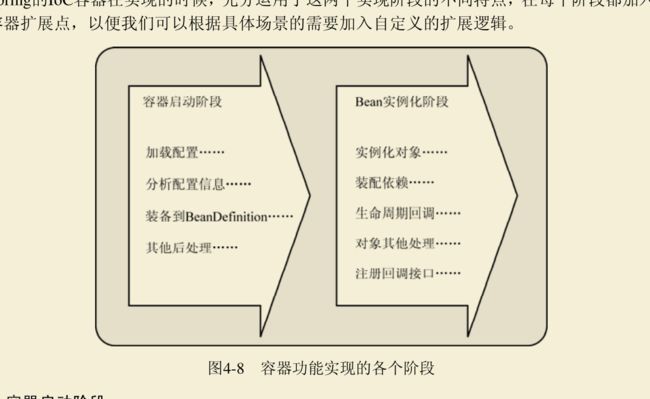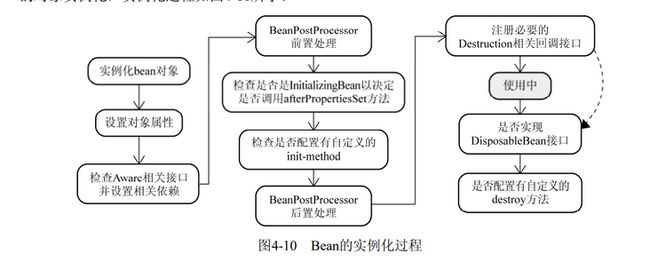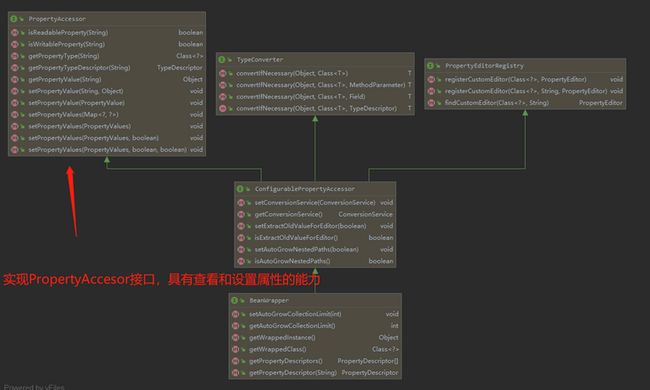之前简单记录了下springBean的生命周期,最近翻开来看了下,发现自己遗漏了很多细节,很多点都衔接不上
今天重新翻看《spring揭秘》,查资料,补了许多细节。希望能够让自己和大家更容易看懂吧
Bean的生命周期的完全实现需要两个阶段
- 容器的启动
- bean的实例化过程(涵盖了bean生命周期的大部分)
容器启动阶段
- 重点是收集到元信息配置信息,即创建bean需要的信息(beanDefinition)
通过BeanDefinitionReader,读取到beanDefinition信息,再通过beanDefinitionRegistry,将BeanDefinition注册到其里面
// 这是 PropertiesBeanDefinitionReader 把从properties文件读取到的配置信息,
// 通过 BeanDefinitionRegistry 注册 BeanDefinition的过程
AbstractBeanDefinition bd = BeanDefinitionReaderUtils.createBeanDefinition(
parent, className, getBeanClassLoader());
bd.setScope(scope); // 作用域 默认singleton
bd.setAbstract(isAbstract); // 是否是抽象 默认false 如果是抽象的,容器不会实例化bean,而是将beanDefinition信息作为其子类使用
bd.setLazyInit(lazyInit); // 懒加载 默认false 如果是false,容器一启动就会加载bean
bd.setConstructorArgumentValues(cas); // 构造参数
bd.setPropertyValues(pvs); // 属性信息
getRegistry().registerBeanDefinition(beanName, bd); // 注册BeandefinitionBeanDefinitionReader 有多种,包括:
- PropertiesBeanDefinitionReader 读取Properties配置文件
- GroovyBeanDefinitionReader 读取Groovy配置文件
- XmlBeanDefinitionReader 读取Xml配置文件
bean实例化前 对beanDefinition做出自定义修改
BeanFactoryPostProcessor实例化bean之前,可以允许修改beanDefinition信息,下面是spring默认实现的BeanFactoryPostProcessor类:
PropertyPlaceholderConfigurer允许我们在XML配置文件中使用占位符(PlaceHolder),并将这些占位符所代表的资源单独配置到简单的properties文件中来加载PropertyOverrideConfigurer覆盖对象的属性值- 我们可以自己实现
BeanFactoryPostProcessor依赖注入beanFactory,修改beanDefinition信息
bean实例化阶段
doCreateBean源码方法(下面仅对beanFactory容器做解析,applicationContext容器其实大同小异)
/**
* Actually create the specified bean. Pre-creation processing has already happened
* at this point, e.g. checking {@code postProcessBeforeInstantiation} callbacks.
* Differentiates between default bean instantiation, use of a
* factory method, and autowiring a constructor.
* @param beanName the name of the bean
* @param mbd the merged bean definition for the bean
* @param args explicit arguments to use for constructor or factory method invocation
* @return a new instance of the bean
* @throws BeanCreationException if the bean could not be created
* @see #instantiateBean
* @see #instantiateUsingFactoryMethod
* @see #autowireConstructor
*/
protected Object doCreateBean(String beanName, RootBeanDefinition mbd, @Nullable Object[] args)
throws BeanCreationException {
// Instantiate the bean.
BeanWrapper instanceWrapper = null;
if (mbd.isSingleton()) {
instanceWrapper = this.factoryBeanInstanceCache.remove(beanName);
}
if (instanceWrapper == null) {
instanceWrapper = createBeanInstance(beanName, mbd, args);
}
// 实例化bean
Object bean = instanceWrapper.getWrappedInstance();
Class beanType = instanceWrapper.getWrappedClass();
if (beanType != NullBean.class) {
mbd.resolvedTargetType = beanType;
}
// Allow post-processors to modify the merged bean definition.
synchronized (mbd.postProcessingLock) {
if (!mbd.postProcessed) {
try {
applyMergedBeanDefinitionPostProcessors(mbd, beanType, beanName);
}
catch (Throwable ex) {
throw new BeanCreationException(mbd.getResourceDescription(), beanName,
"Post-processing of merged bean definition failed", ex);
}
mbd.postProcessed = true;
}
}
// Eagerly cache singletons to be able to resolve circular references
// even when triggered by lifecycle interfaces like BeanFactoryAware.
boolean earlySingletonExposure = (mbd.isSingleton() && this.allowCircularReferences &&
isSingletonCurrentlyInCreation(beanName));
if (earlySingletonExposure) {
if (logger.isTraceEnabled()) {
logger.trace("Eagerly caching bean '" + beanName +
"' to allow for resolving potential circular references");
}
addSingletonFactory(beanName, () -> getEarlyBeanReference(beanName, mbd, bean));
}
// Initialize the bean instance.
Object exposedObject = bean;
try {
// 填充bean对象属性
populateBean(beanName, mbd, instanceWrapper);
// 初始化bean
exposedObject = initializeBean(beanName, exposedObject, mbd);
}
catch (Throwable ex) {
if (ex instanceof BeanCreationException && beanName.equals(((BeanCreationException) ex).getBeanName())) {
throw (BeanCreationException) ex;
}
else {
throw new BeanCreationException(
mbd.getResourceDescription(), beanName, "Initialization of bean failed", ex);
}
}
if (earlySingletonExposure) {
Object earlySingletonReference = getSingleton(beanName, false);
if (earlySingletonReference != null) {
if (exposedObject == bean) {
exposedObject = earlySingletonReference;
}
else if (!this.allowRawInjectionDespiteWrapping && hasDependentBean(beanName)) {
String[] dependentBeans = getDependentBeans(beanName);
Set actualDependentBeans = new LinkedHashSet<>(dependentBeans.length);
for (String dependentBean : dependentBeans) {
if (!removeSingletonIfCreatedForTypeCheckOnly(dependentBean)) {
actualDependentBeans.add(dependentBean);
}
}
if (!actualDependentBeans.isEmpty()) {
throw new BeanCurrentlyInCreationException(beanName,
"Bean with name '" + beanName + "' has been injected into other beans [" +
StringUtils.collectionToCommaDelimitedString(actualDependentBeans) +
"] in its raw version as part of a circular reference, but has eventually been " +
"wrapped. This means that said other beans do not use the final version of the " +
"bean. This is often the result of over-eager type matching - consider using " +
"'getBeanNamesForType' with the 'allowEagerInit' flag turned off, for example.");
}
}
}
}
// Register bean as disposable.
try {
// 检查是否实现DisposableBean接口,有的话注册销毁回调方法
registerDisposableBeanIfNecessary(beanName, bean, mbd);
}
catch (BeanDefinitionValidationException ex) {
throw new BeanCreationException(
mbd.getResourceDescription(), beanName, "Invalid destruction signature", ex);
}
return exposedObject;
}
- 首先第一步,调用
createBeanInstance方法,利用反射调用类的构造方法,实例化bean,返回beanWrapper对象,再调用getWrappedInstance方法得到实例化的bean,beanWrapper对象具有获取对象属性的功能,所以可以调用populateBean用来实现属性填充。
开始实例化bean之前,会检查bean有没有实现过
Aware接口,如果有则实现。// AbstractAutowireCapableBeanFactory类中的 initializeBean方法 private void invokeAwareMethods(String beanName, Object bean) { if (bean instanceof Aware) { // 如果Spring容器检测到当前对象实例实现了该接口,会将该对象实例的bean定义对应的beanName设置到当前对象实例。 if (bean instanceof BeanNameAware) { ((BeanNameAware) bean).setBeanName(beanName); } // 如果容器检测到当前对象实例实现了该接口,会将对应加载当前bean的Classloader注入当前对象实例。 // 默认会使用加载org.springframework.util.ClassUtils类的Classloader if (bean instanceof BeanClassLoaderAware) { ClassLoader bcl = getBeanClassLoader(); if (bcl != null) { ((BeanClassLoaderAware) bean).setBeanClassLoader(bcl); } } if (bean instanceof BeanFactoryAware) { ((BeanFactoryAware) bean).setBeanFactory(AbstractAutowireCapableBeanFactory.this); } // 以上几个Aware接口只是针对BeanFactory类型的容器而言 } }
对于ApplicationContext类型容器,会额外实现几个Aware接口
- BeanPostProcessor阶段
BeanPostProcessor的概念容易与BeanFactoryPostProcessor的概念混淆。
但只要记住BeanPostProcessor是存在于对象实例化阶段,而BeanFactoryPostProcessor则是存在于容器启动阶段,这两个概念就比较容易区分了。
BeanPostProcessor 有两个需要子类实现的方法
public interface BeanPostProcessor {
/**
* 调用bean的init方法之前做的前置处理
*/
@Nullable
default Object postProcessBeforeInitialization(Object bean, String beanName) throws BeansException {
return bean;
}
/**
* 调用bean的init方法之后做的前置处理
*/
@Nullable
default Object postProcessAfterInitialization(Object bean, String beanName) throws BeansException {
return bean;
}
}在initializeBean方法内可以看到BeanPostProcessor的调用顺序
protected Object initializeBean(String beanName, Object bean, @Nullable RootBeanDefinition mbd) {
if (System.getSecurityManager() != null) {
AccessController.doPrivileged((PrivilegedAction注意:applcationContext容器中实现BeanPostProcessor接口的postProcessBeforeInitialization中,会对实现了Aware接口的bean进行invoke调用。
这里和BeanFactory有些不同,BeanFactory是在BeanPostProcessor之前实现的
- InitializingBean和init-method
这两个方法都是在invokeInitMethods方法里调用,InitializingBean接口需要实现afterPropertiesSet 方法允许bean实例在设置完所有bean属性后执行其整体配置验证和最终初始化。init-method, 对于用户来说可以自定义方法的名称,也可以统一设置所有对象的initMethod比较灵活,避免修改代码,耦合性低。
- DisposableBean与destroy-method
DisposableBean接口,子类需要实现destroy方法,来销毁对象,只适用于单例对象,不是单例的话,需要交给调用者自己销毁。destroy-method注册销毁函数,作用和destroy方法同理
总结
本文主要讲了bean在BeanFacotry容器的生命周期,applicationContext容器稍微提了几点不同,applicationContext容器增加更多的特性,像事件发布监听,国际化信息支持等。
bean的生命周期主要涉及到容器的加载和bean的实例化。
容器的加载:
- 加载资源文件到beanDefinition(元信息)
- 调用实现了BeanFactoryPostProcessor接口的方法,可以对beanDefinition进行修改。
bean的实例化:
- 利用反射+beanDefinition元信息实例化得到对象
- populateBean方法填充属性
- 检验对象是否实现过Aware接口,有则调用其实现
- 如果对象有实现BeanPostProcessor接口,需要先实现前置方法
- 调用InitializingBean和init-method方法 如果有实现或标记的话
- 再调用BeanPostProcessor接口的后置方法
- 最后查看对象是否实现 DisposableBean与destroy-method 来销毁bean(DisposableBean接口只针对单例bean)
资料:
《spring揭秘》王福强
本文由mdnice多平台发布


